If you’ve already read yesterday’s article – “Bell Cow or Bust” – then an introduction for today’s article isn’t necessary. If you haven’t read yesterday’s article then please do so now. No, seriously… All done? Okay, good. So, who will be a bell-cow running backs in 2020? Who are the running backs I’m drafting in 2020 and in what order? I’m glad you asked. Notes: If you read yesterday’s article, you’ll know I’m unique with my approach to the running back position. As such, I need to emphasize that these are my running back rankings. You can find our site rankings here.
Christian McCaffrey, RB, Carolina Panthers
ADP: RB1, DFB: RB1, Diff: 0
Key Stat: If McCaffrey’s season ended in Week 11, he still would have led all running backs in fantasy points.
In 2019, McCaffrey became the first running back in at least a decade (maybe ever) to play on over 1,000 snaps. In total, he commanded 287 of 309 carries (92.8%) and 142 of 153 targets out of the backfield (92.8%). His 25.3 weighted opportunity points per game ranks third-most all time, and his 29.5 fantasy points per game ranks fifth-most all-time. And that’s what this was, an all-time season – McCaffrey’s 2019 season rivals only the best years of Marshall Faulk and LaDainian Tomlinson as the archetypal bell-cow season.
The only on-paper concern with McCaffrey is regime uncertainty – Joe Brady replacing OC Scott Turner. Although Brady has at least paid lip service to the notion of reducing McCaffrey’s touch totals, he also was the mastermind behind an all-time bell-cow season last year. In 2019 Clyde Edwards-Helaire added 215 carries to an SEC record 55 receptions as the linchpin of the National Champion LSU Tigers offense.
In reality, McCaffrey is probably the biggest no-brainer 1.01 we’ve seen in a long time. And actually, probably the closest thing to peak LaDainian Tomlinson ever. Meaning, the 1.01 is an incredible advantage this year – more so than most years. If you’re lucky enough to land the first-overall pick in your draft, congratulations, it’s all about trying not to screw things up from here. If you weren’t, I don’t know, maybe your best strategy is just lobbying your commissioner to move over to an auction-style draft.
Saquon Barkley, RB, New York Giants
ADP: RB2, DFB: RB2, Diff: 0
Key Stat: Whether on tape or by the numbers it seems clear Barkley came back a bit too soon from a high-ankle sprain suffered in Week 3. From Weeks 3-14 Barkley averaged just 3.06 YPC and 13.6 fantasy points per game. Across Barkley’s other five games he averaged a whopping 27.1 fantasy points per game along with a ridiculous 6.74 YPC.
Okay, McCaffrey is the lock 1.01, but Barkley is the lock 1.02, providing you with a massive advantage over all teams drafting behind you.
The only concern with Barkley, like with McCaffrey, is the loss of a bell-cow-loving play-caller in Pat Shurmur in exchange for an OC carrying a bit more uncertainty in Jason Garrett (who hasn’t called plays since 2011). That being said, over the past six seasons, Garrett has leaned massively run-heavy while primarily utilizing a bell cow over this span (remember Demarco Murray’s 449-touch season?). And besides, it’s Saquon freaking Barkley – Garrett would have to be fired by mid-season if Barkley isn’t ranking top-three in snap share and weighted opportunity points per game.
Look for Barkley to benefit from the best offense, the best offensive line, and the best gamescript of his career, on his way to a potentially historic finish.
Alvin Kamara, RB, New Orleans Saints
ADP: RB4, DFB: RB3, Diff: +1
Key Stat: Over the past three seasons (and of 70-plus qualifiers in each season), Kamara has finished first (2017), first (2018), and 19th in fantasy points per snap (2019).
Kamara finished eighth in fantasy points per game (17.8) last season, after prior finishes of fourth in 2018 (23.6) and fourth in 2017 (20.0). Although that may seem like a disappointment, keep in mind he was playing at just 75%, “on only one leg”, after tearing a ligament in his knee in Week 6, and also dealing with ankle and back injuries for over half of the season.
Although Kamara spent only three official weeks on the injury report (Weeks 6-8), it was clear we were never getting the full story. Through the first five weeks of the season (before his injury), Kamara led all of 38 running backs in Elusive Rating (per PFF). Throughout the remainder of the season, he ranked just 34th of 40 running backs.
That’s especially alarming because – without exaggeration – Kamara is arguably the most efficient fantasy running back of all-time. Since the NFL merger (in 1970), there have been 2,255 instances of a running back drawing at least 100 carries in a single season. Of those, Kamara’s 2017 season ranks first in fantasy points per touch (1.59). His 2018 season ranks 13th (1.29) – making him the only running back with multiple seasons in the top-25. His 2019 season, however, ranked just 218th (0.99).
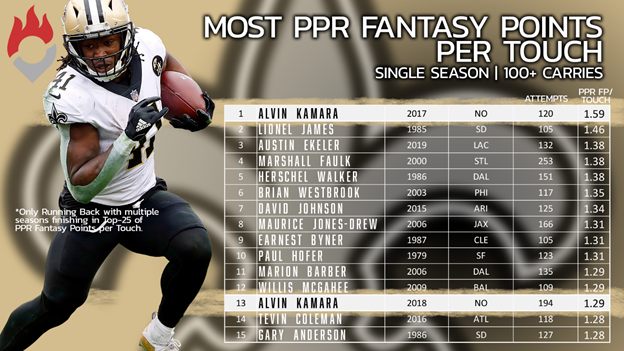
So, Kamara’s diminished efficiency certainly hurt him, but keep in mind, he also saw the best volume of his career in 2019. When Kamara was healthy (Weeks 1-5), he was averaging 72% of the team’s snaps, 76% of the carries, and 81% of the targets out of the backfield. And even after the injury, his splits were still better than what they were from 2017-2018, when he ranked behind only Todd Gurley in fantasy points. Over this span, he received just 51.8% of the team’s snaps, 41.9% of the carries, and 67.8% of the targets out of the backfield. In other words, he was far from a bell-cow running back, and still consistently one of the most valuable running backs in fantasy. (That almost never happens).
Look for a fully-healthy Kamara, the league’s most efficient running back, to absolutely dominate in 2020, feasting in a long-overdue bell-cow role.
Clyde Edwards-Helaire, RB, Kansas City Chiefs
ADP: RB7, DFB: RB4, Diff: +3
Key Stat: Over the past two seasons, when playing on at least 60% of Kansas City’s snaps (11 such games), Damien Williams averaged 25.0 fantasy points per game. Keep in mind, Edwards-Helaire is much better than Williams, and will earn a snap share far greater than just 60%.
As far as landing spots go, it might not get any better than Kansas City. The Chief’s Andy Reid-orchestrated Patrick Mahomes-led offense may go down in history as the greatest of all-time. At the very least, they’re this season’s favorites for yards, touchdowns, and points scored. On top of that, Reid is easily the best coach to have calling plays for your fantasy running back. In 13 of the past 16 seasons, Andy Reid’s RB1 has finished top-eight among running backs in fantasy points per game (81%). No other NFL coach or play-caller comes close.
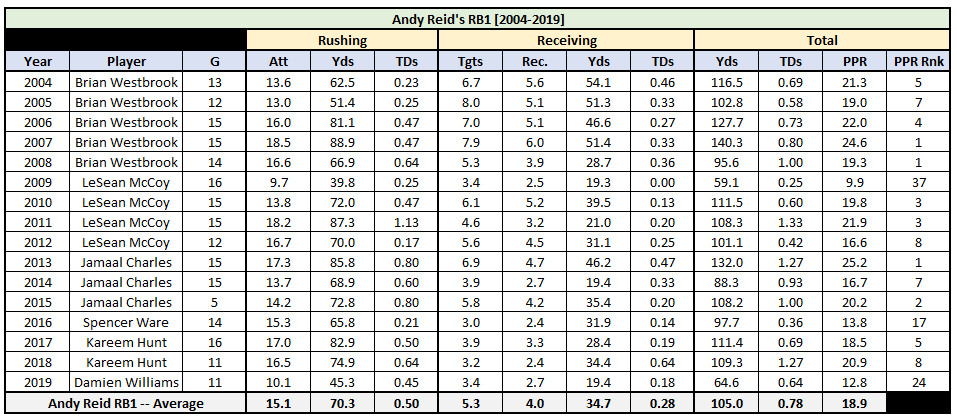
As far as talent’s concerned, I don’t think that’s in question either. Edwards-Helaire just set the SEC record for receptions by a running back. (Remember, in PPR leagues, targets are worth 2.73x as much as a carry.) In mid-April, our own running back expert Graham Barfield called him the best route runner to come out of college since McCaffrey. That’s all going to be important in Reid’s pass-to-set-up-the-run spread offense, but he’s no slouch as a runner either. He just set all-time marks in PFF rushing grade (fifth-best since 2014) and missed tackles forced per carry (fifth-best since 2014).
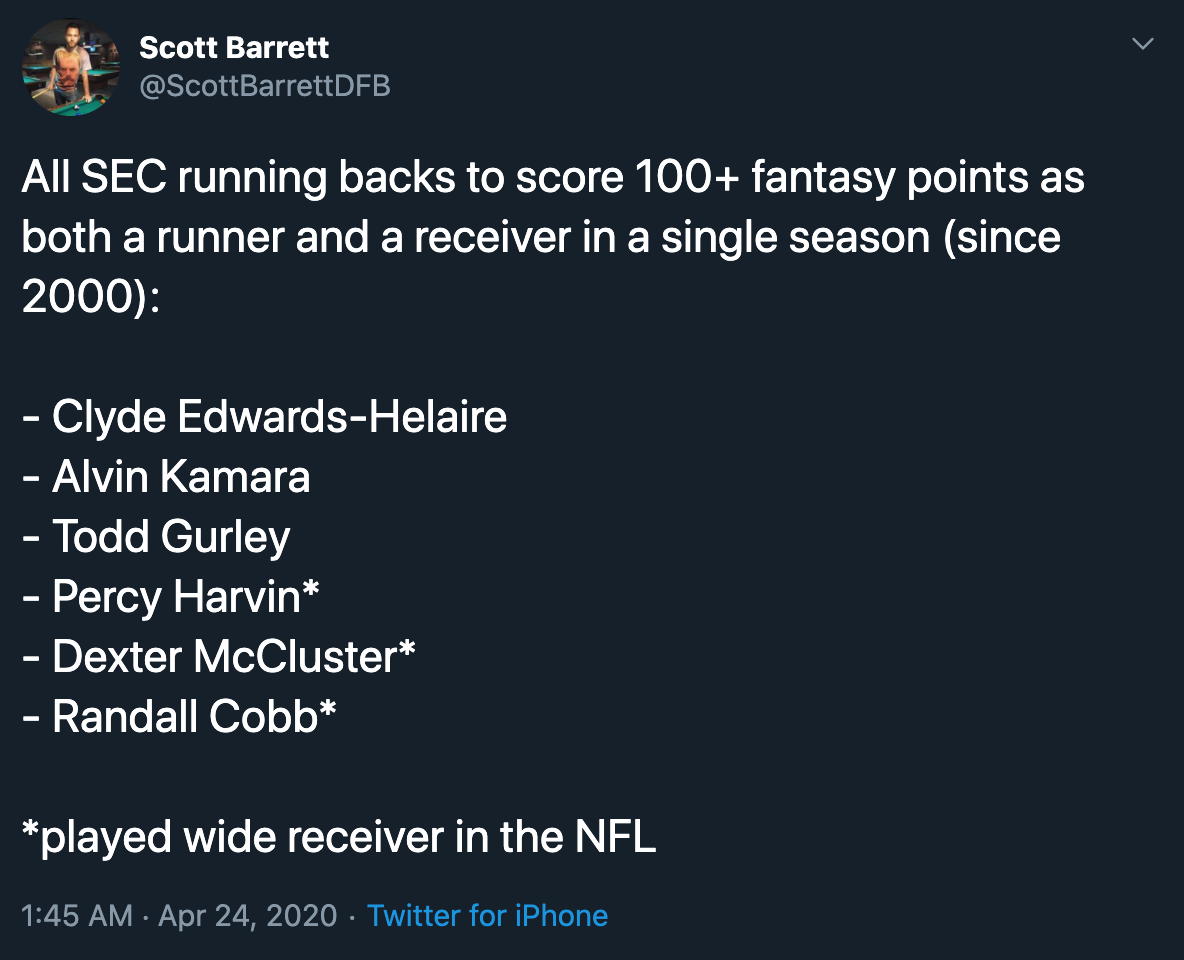
But what about volume in Year 1? Considering I was already drafting Edwards-Helaire top-12 before the Damien Williams opt-out, obviously I don’t see that as a concern. Why? Because they paid a substantial price for their new running back (Round 1 draft capital), and he was extremely highly coveted. Reid and Brett Veach (and even Mahomes) made this point very clear. They knew he was going to be their pick before the Draft even started. They view him as “a featured back” fully capable of being able to handle and “thrive” in a bell-cow workload. Veach compared him to McCaffrey. Reid said he was better than Brian Westbrook. (From 2004-2008, under Reid, Westbrook averaged 21.4 fantasy points per game, which ranked behind only LaDanian Tomlinson.)
Edwards-Helaire will be a top-five running back in 2020.
Ezekiel Elliott, RB, Dallas Cowboys
ADP: RB3, DFB: RB5, Diff: -2
Key Stat: In his last three seasons coaching, Mike McCarthy's Packers ranked 32nd, 29th, and 29th in run%. Over the same span, Dallas ranked 11th, fourth, and first.
It’s hard to argue against Elliott, who has ranked third (82.5%), first (89.7%), and second (88.3%) in snap% over the past three seasons. Or, over the past four seasons, fifth (18.6), first (22.5), third (20.8), and fifth (17.1) in weighted opportunity points per game. I think it’s probably more likely Elliott finishes first in rushing yards per game – as he has in three of his four career seasons – than that he loses bell-cow status in 2020. But I do have two concerns. One, is that he saw Jason Garrett replaced by Mike McCarthy, but I think that concern is somewhat mitigated by the fact that Kellen Moore remains as OC and play-caller. Two, is that Tony Pollard is really freaking good. And I think this is a problem. It’s going to be hard for Dallas to keep Pollard off the field – I do think Pollard eats into a larger portion of Elliott’s work this year, and I do think that makes him a bit riskier and does cap his ceiling. But even so, Elliott still feels like a lock for 275 carries and 50 receptions.
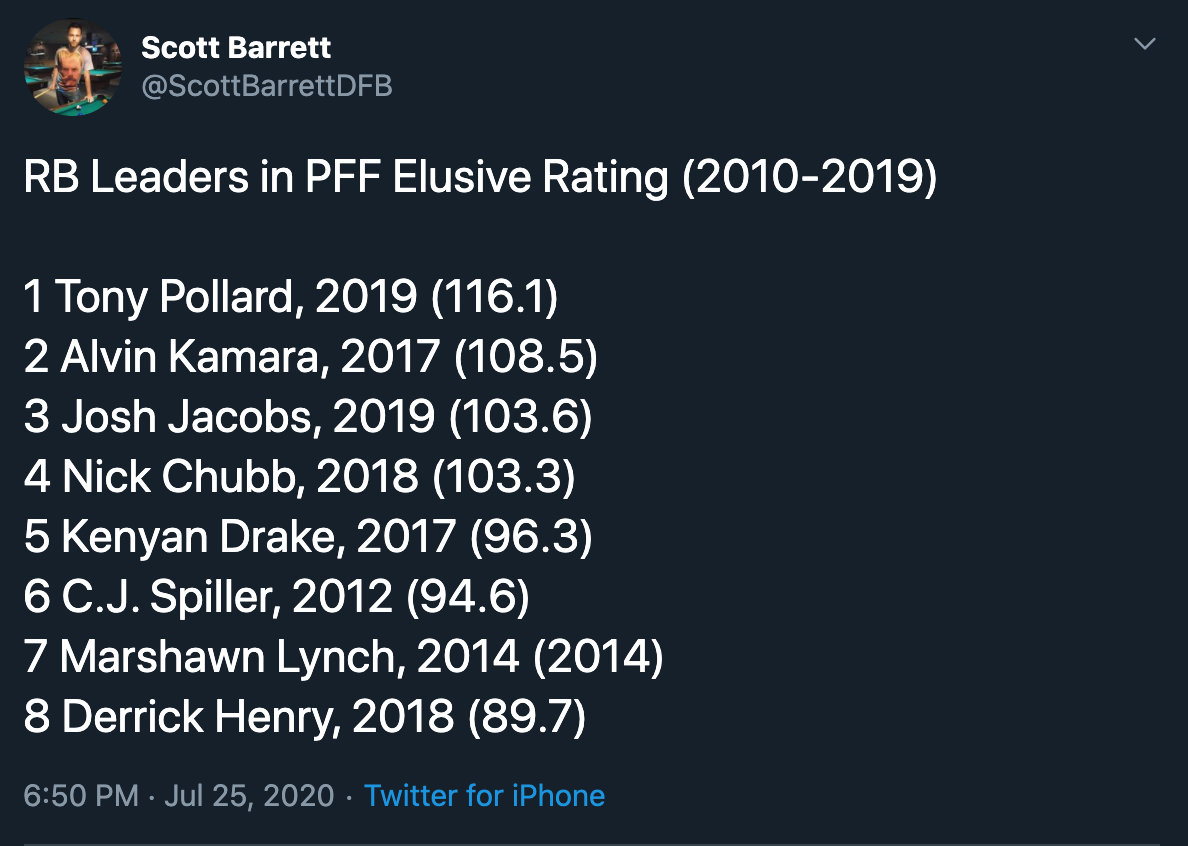
Dalvin Cook, RB, Minnesota Vikings
ADP: RB5, DFB: RB6, Diff: -1
Key Stat: Over the past two seasons, Cook ranks behind only Nick Chubb in missed tackles forced per touch.
Adjusting for the fact that Cook sat out the fourth quarter in four of his games last year (due to blowouts and injury), Cook averaged 19.5 weighted opportunity points per game and 22.5 fantasy points per game on a 73.7% snap share. For perspective, those numbers would have ranked third-, second-, and seventh-best, respectively. In addition to top-end talent, which Cook undoubtedly has, he also has one of the league’s all-time running back gurus as his OC. A Gary Kubiak-led offense has ranked top-seven in rushing yards in 14 of 23 (61%) career seasons. That’s pretty absurd.
The only real concern with Cook is injury risk, which is not something I typically worry about too much. But in his case it’s real and it’s not pretty.
Miles Sanders, RB, Philadelphia Eagles
ADP: RB9, DFB: RB7, Diff: +2
From Weeks 11-16, Sanders ranked fifth in snaps per game (58.6), sixth in weighted opportunity points per game (17.9), and seventh in fantasy points per game (18.8). Sanders surely benefited from a lack of in-position depth and competition due to injury, but he was also undoubtedly a bell cow over this span (72.7% of the team’s snaps). In Week 17, Sanders exited early with an injury (the Eagles’ first drive of the second quarter), but not before already receiving nine carries and five targets. Accounting for that, it was clear Sanders was seeing top-five volume, averaging 15.9 carries, 5.5 targets, 18.6 weighted opportunity points, and 105.5 scrimmage yards per game. It is extremely rare for a rookie running back to see this sort of opportunity (especially in the passing game), but Sanders got it and thrived in that role.
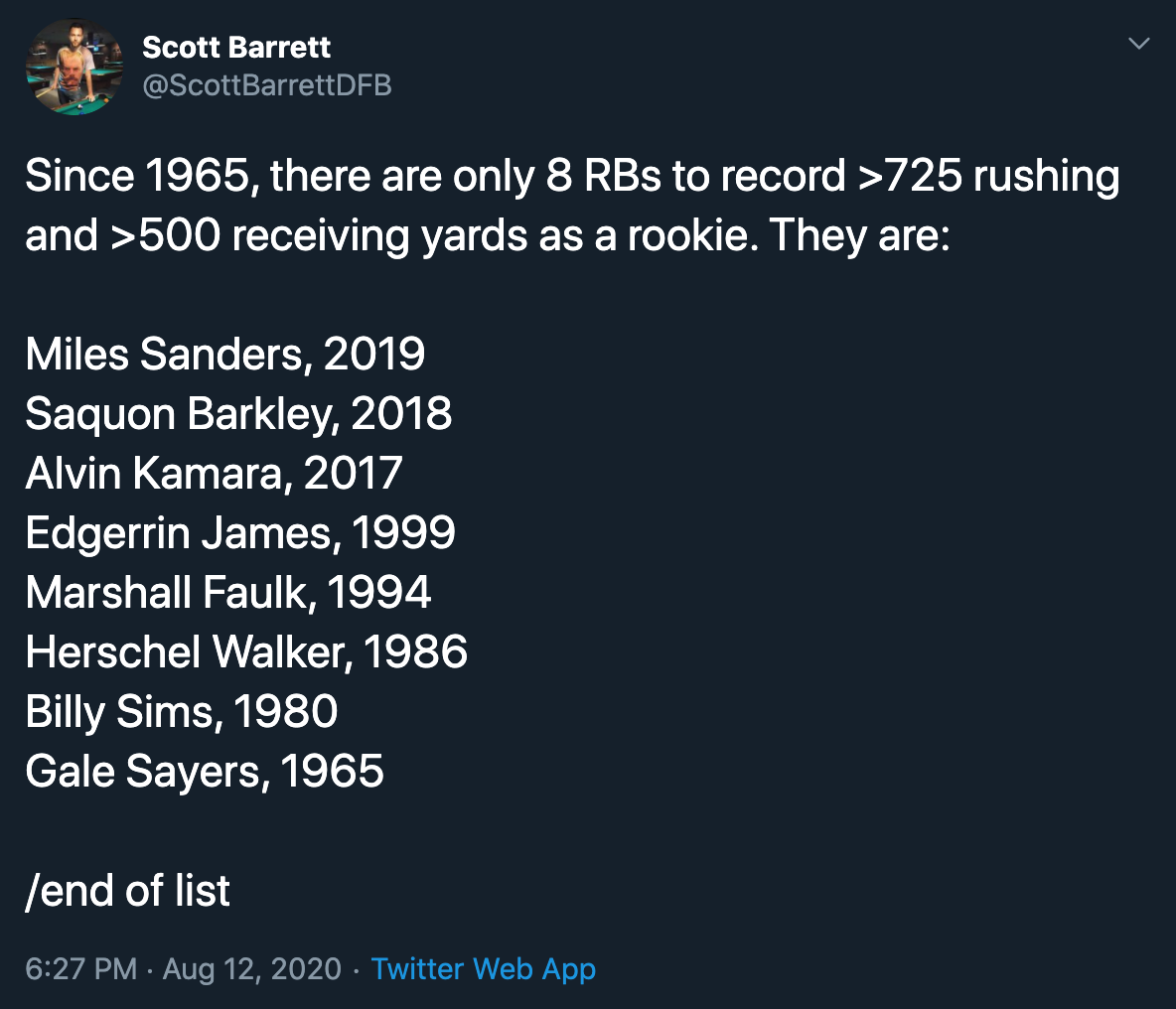
Concerns citing Doug Pederson’s preference for a committee running back are unfounded. After drafting Sanders in 2019 (in the second round), GM Howie Roseman said, “Miles is a guy who can play all three downs.” Last month RB Coach Duce Staley said, “I’m excited about him handling the full load. I don’t see Miles as a guy that you have to monitor his touches. Maybe 15 rushes, five passes. No. I don’t see him that way. You put him in and let him go.” Earlier this month, he added, “Miles can do it all… You want to put the ball in his hands as much as possible.” Just last week, Pederson said he told Sanders, “You’re the guy this season.” Carson Wentz said Sanders is going to spend more time lining him up in the slot as a “coverage nightmare” for opposing defenses. Our own NFL Insider Adam Caplan put it simply enough, “No RBBC. Special talent=fantasy gold.”
Kenyan Drake, RB, Arizona Cardinals
ADP: RB10, DFB: RB8, Diff: +2
Key Stat: In 2018, and among all 64 Power-5 teams, Kliff Kingsbury’s Texas Tech offense ranked third in snaps per game (84.8), fourth in pass percentage (57.9%), and fifth in targets to running backs (78). In 2019, Arizona’s RB1 ranked seventh in weighted opportunity points per game.
In 54 games with Miami, Drake exceeded a dozen touches only 15 times. But in those games, he always managed to impress, averaging 16.8 fantasy points per game. For comparison’s sake, 16.8 fantasy points per game would have ranked right behind Leonard Fournette last year, who hit 15 touches in all 15 of his games, averaging 22.7 per game. It was clear the potential was always there with Drake, he just needed the right landing spot.
In Arizona, it’s a near-perfect one. Last year, Arizona’s RB1 (defined as the team’s highest-scoring running back in any given game) ranked fifth in fantasy points per game (20.2), behind only Carolina, Green Bay, Los Angeles (Chargers), and Minnesota. From his first game in a Cardinals’ uniform until the end of the season, Drake averaged 16.2 weighted opportunity points, 50.6 snaps, and 19.9 fantasy points per game. For perspective, those numbers would have ranked eighth-, seventh, and third-best at the position last year.
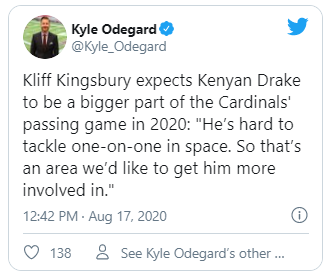
And everything about Drake’s situation looks better now than it did last year. The team fully committed to Drake, making him the eighth-highest-paid running back of the 2020 season. He’ll have a full offseason to learn the plays and for HC Kliff Kingsbury to design plays that work best for him. And, of course, the offense appears much more potent and with improved blocking upfront, after adding WR DeAndre Hopkins and OT Josh Jones (PFF’s No. 4 offensive lineman in the draft).
Joe Mixon, RB, Cincinnati Bengals
ADP: RB8, DFB: RB9, Diff: -1
Following the arrival of Joe Burrow and the healthy returns of LT Jonah Williams and WR A.J. Green, look for Mixon to benefit from a better offense, an improved offensive line, less defensive pressure, more favorable gamescript, more red zone drives, the most-improved strength of schedule at the position, and more. But, after finishing just 20th in fantasy points per game last season, that all feels already priced in.
If you’re drafting Mixon at ADP, it’s based on the premise that he will finally be featured in the passing game, and thus reach bell cow-status. Over the past three seasons, 36 different running backs exceeded 300 receiving yards at least once. Players like Andre Ellington, Jacquizz Rodgers, and Kyle Juszczyk (twice!) all made the list, but not Mixon. Why not? I have no idea! Mixon averaged 2.70 yards per route run in his final season at Oklahoma, and that mark still stands as one of the 10 best of the PFF College-era (2014-2019). Coming into the draft, PFF’s comp for him was an all-time bell cow in Matt Forte.
Last season, after the team’s Week 9 bye, Mixon came very close to bell cow-status, playing on 63% of the team’s snaps, averaging 45.4 snaps per game (11th-most), 17.4 weighted opportunity points per game (sixth-most), and 18.2 fantasy points per game (seventh-most). That’s despite the fact that Cincinnati won just two of those seven games. The bad news is, over this stretch Mixon still only ranked 36th in targets per game (2.5), and Giovani Bernard still ran more routes over this span.
If Mixon can earn full bell-cow-status, there’d really only be a handful of names more valuable in fantasy. Unfortunately, I don’t see that happening this year. Based on coaching comments, it seems likely Bernard is still locked into that passing-down role. That said, the coaches do claim to want to increase his reception totals, giving him a workload similar to (or maybe even slightly better than) the one he saw at the tail-end of last year. And even if he is more gamescript-sensitive than a true bell cow, he feels like an RB1-lock based on the improved situation from last year.
Josh Jacobs, RB, Las Vegas Raiders
ADP: RB14, DFB: RB10, Diff: +4 Key Stat: Jacobs led the 2019 running back class in career yards per route run, but he also never eclipsed 20 receptions in a single season.
Last season, as a rookie, Jacobs led all running backs in missed tackles forced per touch (0.30) and Elusive Rating (103.6). And, not only did he lead the league, but these were historically great marks – ranking, respectively, third- and second-best by any running back this past decade. Somehow, he put together one of the most efficient seasons in recent memory (by two of PFF’s stickiest and most-predictive metrics) while playing through a fractured shoulder for over half of his season.
Jacobs is very similar to Mixon for me. In a worst-case scenario, he’s still a hyper-talented early-down-workhorse in an improved offense. In a best-case scenario, he’s finally used in the passing game, and flirts with top-six-potential among the elite bell cows. But will that happen?
The team extended scatback Jalen Richard in February, but to a meager salary, and the team didn’t have much depth at the position beyond him. They also drafted “running back” Lynn Bowden on Day 2. But Bowden also isn’t really a true running back, playing quarterback and slot wide receiver at Kentucky.
According to GM Mike Mayock, Raiders beat reporter Vic Tafur (of The Athletic), and Jacobs himself, we should be looking at a fringe bell-cow season from Jacobs this year.
1) Mayock told our own John Hansen in February that Year 2 is Phase 2 for Jacobs, which means an expanded role in the passing game. Matthew Berry and RosterWatch posted similar reports.
2) Per Tafur, “Gruden… vowed that Jacobs would get more carries and more receptions [this year]… [H]e will be the bell cow, with Richard the backup [as opposed to third-down back] and Bowden being worked in slowly.”
3) It certainly doesn’t mean as much coming from Jacobs himself, but he did tell reporters his goal is to “catch at least 60 balls this year.” By weighted opportunity, 60 catches through 16 games would have been worth an additional 4.5 weighted opportunity points per game, bumping him from 16th (14.9) to fourth at the position (19.4).
On paper, Jacobs’ situation really isn’t much different from Mixon’s, or even Sanders’. So why is he going 10 picks later? I don’t know.
Austin Ekeler, RB, Los Angeles Chargers
ADP: RB13, DFB: RB12, Diff: +1
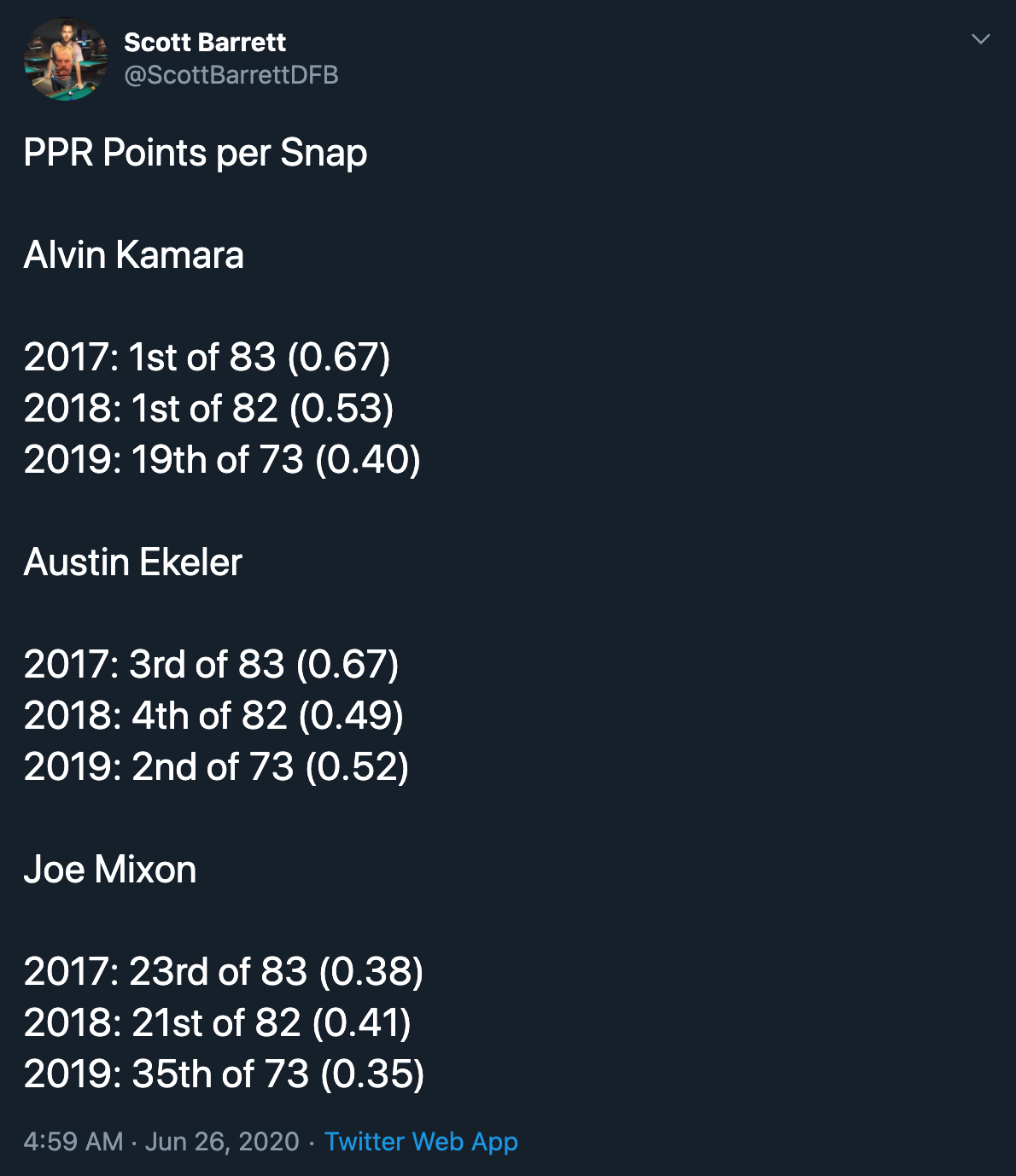
In Weeks 1-4, without Melvin Gordon, Ekeler was used as a true bell cow, playing on 71% of the snaps and averaging a whopping 26.8 fantasy points per game (second-most). Once Gordon returned, Ekeler was stuck in a full-blown committee, playing on only 53% of the snaps. Even so, he still ranked fifth in fantasy points over this span, averaging 16.8 fantasy points per game. However, his volume wasn’t anywhere near as good. In spite of ideal gamescript (Los Angeles went 3-9), Ekeler ranked just 15th in weighted opportunity points per game (15.1) over this stretch, averaging just 6.3 carries and 6.9 targets per game.
Ekeler is already one of the best pass-catching running backs in the NFL, and might just be the discount version of Kamara. (Remember, in PPR leagues, targets are worth 2.73x as much as a carry.) He’s arguably the league’s most efficient running back over the past three seasons, posting top-end efficiency numbers in each season. And last year he posted a historically great season by fantasy points per touch (second-best since 1970) and yards per route run (second-best since 2010). Outscoring his expectation by +3.5 fantasy points per game means he’s due for an efficiency regression, but – based on his history – maybe not as much as a typical running back.
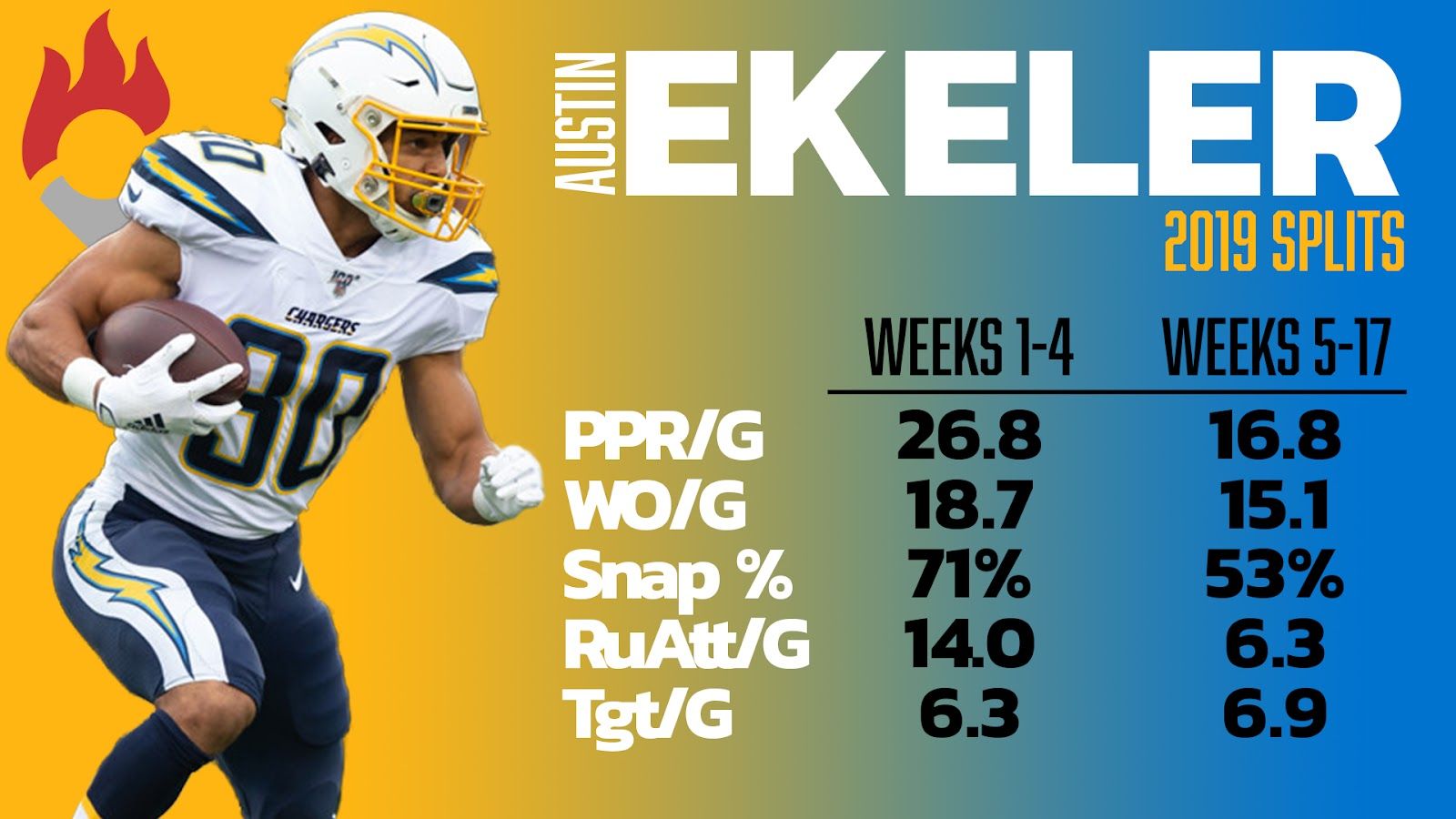
If Ekeler sees the work he saw without Gordon last season (14.0 carries, 6.3 targets, 18.7 weighted opportunity points per game), then he’s basically Alvin Kamara (albeit in a less sexy offense) and should be viewed as such. If he’s who he was once Gordon returned – and, keep in mind, Los Angeles is projected to win +2.5 more games this year – he should be treated as just a high-end RB2. If he’s somewhere in between, well… you can do the math.
So what will Ekeler’s workload look like this year, with Gordon now in Denver? Excluding a Round 4 rookie in Joshua Kelley, Ekeler’s situation seems identical to the one he was in to start last year (during Gordon’s holdout). Unfortunately, that seems optimistic. OC Shane Steichen told reporters in May we should be looking forward to a three-way committee in 2020. Ekeler really could be a league-winner in 2020 (like he was last year), and it would really just come down to that additional rushing work (+7.7 carries per game), but I don’t think that’s terribly likely.
James Conner, RB, Pittsburgh Steelers
ADP: RB19, DFB: RB13, Diff: +6
In 2018, Conner spent the final four weeks of the season on the injury report with an ankle sprain, sitting out for the entirety of your fantasy postseason. Prior to that, Conner was averaging 19.0 weighted opportunity points- and 22.3 fantasy points per game. For perspective, both numbers would have ranked top-six among running backs.
In 2019, Conner suffered a knee injury in Week 2, a quadricep injury in Week 6, and then a shoulder injury in Week 8. He would then spend seven of the team’s final nine games on the injury report, missing six of those games. However, prior to that, Conner was averaging 15.9 weighted opportunity points- and 17.8 fantasy points per game. For perspective, both numbers would have ranked top-eight among running backs. (And keep in mind, that’s including the knee injury and the quadricep injury on a Ben Roethlisberger-less Steelers offense.)
By all accounts, Conner’s 2018 and 2019 role should remain intact in 2020. According to one beat writer in August: “Conner is still the No. 1 option for the Steelers and a running back by committee approach seems like a longshot at this point.” Per Mike Tomlin in May:
“I’m a featured-runner type guy by mentality… Usually when it’s going well, it’s because you have a lead dog out front, and that guy is the featured runner. James is a featured guy and proven runner when healthy. We’re excited about him getting back to health and displaying that in 2020."
Add it all up and Conner looks like a massive ADP-value – maybe the best injury discount in a long time – and a guaranteed bell-cow so long as he stays healthy. But, okay, maybe that’s a big “if”.
Melvin Gordon, RB, Denver Broncos
ADP: RB17, DFB: RB14, Diff: +3
“Phillip Lindsay had 1,000 rushing yards in back-to-back seasons. He’s too good not to get 6-12 touches per game. Gordon might be the RB1A in a committee, but it’ll be a committee.” – Random Guy on Twitter Maybe that’s right. After all, that’s exactly what the price implies – that Gordon is the RB1 in a 60/40 committee. However, I’d argue a bell-cow workload is a more likely outcome.
Although not everyone defines a bell cow as strictly as I do, James Palmer did call Gordon Denver’s “bell cow” following the signing. Ian Rapaport said he was the “bell cow-type running back they’ve been looking for for a number of years…” Adding via humble-brag, “I knew they were looking for a bell cow-type running back, but a lot of people did not.” The contract would imply as much, as Gordon is now the seventh-highest-paid running back in the NFL. And, OC Pat Shurmur not only has a long history of favoring a singular bell-cow running back over a committee, but he actually might have one of the best fantasy running back résumés of any coach in football.
In 11 career seasons as an NFL head coach or offensive coordinator, Shurmur’s RB1 has averaged 17.9 carries, 4.4 targets, and 101.0 yards from scrimmage per game. To clarify, that’s high-end RB1 volume. On a 16-game pace, those numbers come out to 287 carries, 71 targets, 1,615 yards, and – most importantly – 323.2 weighted opportunity points, which would have ranked third-most in 2019. (And keep in mind, this is just Shurmur’s average, which includes seasons from names like Trent Richardson and Peyton Hillis.) Gordon surely fits this prototype, having already proven he can handle a bell-cow workload, averaging 16.5 carries, 4.9 targets, and 99.6 yards from scrimmage per game since 2016. Update: This quote from HC Vig Fangio is concerning, and apparently Gordon has struggled all camp. Off-the-record Denver beat writers who were far more confident in a bell cow workload for Gordon are now telling me to move Gordon and Lindsay closer in my rankings.
Chris Carson, RB, Seattle Seahawks
ADP: RB20, DFB: RB16, Diff: +4
Key Stat: The Seahawks have ranked top-three in rushing attempts in six of the past eight seasons.
Carson totaled 60 yards on nine touches before suffering a season-ending hip fracture in Week 16. Prior to that Week 16 game, Carson was averaging 50.6 snaps per game (seventh-most), 16.8 weighted opportunity points per game (eighth-most), and 16.1 fantasy points per game (11th-most). Keep in mind, he ranks just 20th in ADP this year.
With Rashaad Penny likely to start the season on the PUP list, the Seahawks added insurance in Carlos Hyde, though both Hyde and the team have made it clear Carson’s role will remain unchanged. To reiterate, that role – though maybe not a true bell-cow role with top-five upside (at least not without a few more targets per game) – is a borderline or low-end bell-cow workload and is worth a good deal more than his current price implies (RB20).
Cam Akers, RB, Los Angeles Rams
ADP: RB29, DFB: RB18, Diff: +11
From 2017-2018, Todd Gurley led the league in Snap% (84%), snaps per game (55.6), weighted opportunity points per game (20.6), and fantasy points per game (26.05). For perspective, if Gurley was just 80% of who he was from 2017-2018 in 2019, he still would have finished ahead of all running backs not named “Christian McCaffrey” in fantasy points per game. Or, if 75%, he still would have finished top-three. Or, if just 60%(!), he still would have finished as an RB1.
Ultimately, he was even worse than that (RB16 by FPG), but his usage was strong, finishing sixth in snap% (74.7%) and 14th in weighted opportunity points per game (15.3).
Last season, Gurley was being drafted in Round 2, Darrell Henderson was being drafted in Round 8, and Malcolm Brown was being drafted in Round 14. This year, Akers is being drafted in Round 6 and Henderson in Round 10. What am I trying to say? Recency bias is a hell of a drug. Even though the RB1-role in a Sean McVay-led Rams offense has already proven capable of offering unrivaled upside, because all of those players busted last year, we’re getting Akers at a tremendous discount this year. Let’s call it the “Darrell Henderson discount.”
Akers was a Yards Created standout who surprised on draft day, going to the Rams at pick No. 52. This was their first selection of the draft, and HC Sean McVay told reporters after the selection that Akers was the player he had wanted all along and that he viewed running back as the top need for the Rams. Perhaps hinting at every-down bell-cow potential, both he and GM Les Snead continually praised Akers for his versatility, size, speed, power, and ability to both pass-catch and pass-block.
Let’s say the odds are…
- 75% Akers is stuck in a low-upside three-way RBBC for the entirety of the season, where he, Henderson, and Brown all finish outside of the top-30 running backs.
- 20% Akers is stuck in a low-upside three-way RBBC until being awarded bell-cow status in Week 14
- 5% he’s a bell cow by Week 7
…then he’s still one of the best values in the draft. And truth be told, I think his odds are wildly better than that.
Ronald Jones, RB, Tampa Bay Buccaneers
ADP: RB30, DFB: RB19, Diff: +11
Key Quote: “RoJo is the main guy. He’ll carry the load. All of those other guys are fighting for roles, (for) who goes in second when he gets tired, maybe who is the third-down guy.” – HC Bruce Arians (8/10/2020)
- In 2015, after losing his starting RB to a PCL injury in Week 1, Arians called Chris Johnson “our lead dog” at running back. From Weeks 2-12, Johnson ranked top-five in rushing attempts and yards before breaking his leg.
- Before David Johnson’s breakout season in 2016, Bruce Arians was effusive in praise, calling him “the bell cow” with a “chance to one of the all-time best” running backs in the NFL.
- In 2018, Chris Godwin caught 59 passes on just 64% of the team’s snaps. In 2019, Arians said Godwin “will never come off the field” and can come close to being “a 100-catch guy” in 2019. What happened? He played on 92% of the snaps and was on pace for 98 catches.
- In December, Arians publicly embarrassed Jameis Winston and hinted at replacing him in free agency. Two months later he told reporters (essentially) he would be going hard after Tom Brady, though even weeks later their odds to land him was still just 40-1 by most sportsbooks.
What am I getting at? I know everyone thinks all coaches are liars, but if any one of them is honest, it’s the straight-shooting Arians, who might even be too honest at times.
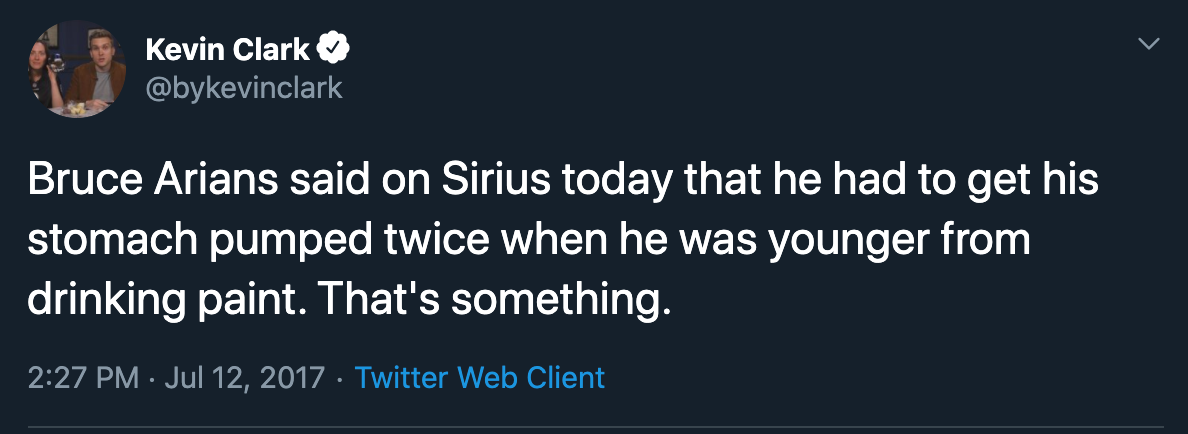
If the quote at the top is true (and I think it is), Jones is mispriced by multiple rounds, as a true bell-cow only coming off the field when he’s tired. “Maybe” if he struggles with passing-down work someone else can steal away that role, but it seems unlikely at the moment. Keep in mind, even if he’s just the early-down workhorse, he’s mispriced. Vegas has Tampa projected to win +2.5 more games this year, with an over/under of 9.5 wins (sixth-most), implying plenty of positive gamescript and red zone opportunities.
Jones might not be a high-end talent, but he is a likely bell-cow mispriced by multiple rounds.
Le’Veon Bell, RB, New York Jets
ADP: RB21, DFB: RB20, Diff: +1
Bell was an all-time bell-cow in Pittsburgh, and then he sat out a year, and then he was disastrous in his first season as a New York Jet. He certainly underwhelmed for fantasy, but he didn’t have volume to blame. He finished the season ranking seventh in weighted opportunity points per game (17.4) and fifth in snaps per game (53.0). Bell was undoubtedly a bell cow last season – 76.0% of the team’s snaps, 76.3% of the carries, and 17.1% target share – but he finished just 18th in fantasy points per game. So, what gives? I thought bell-cow running backs were supposed to be fantasy gold?
Well, typically they are. And I think 9 times out of 10, a season like the one we just saw from Bell would yield at least low-end RB1 production. Instead, Bell posted one of the 25-least-efficient seasons of the past decade. This was partly on him (he played poorly) and partly on a poor environment (remember those Luke Falk games?), but still, this is a number that should regress much closer to the mean next season.
The bigger question is, does Bell see the same sort of volume he saw last year? Because, if you guaranteed me this same sort of volume in 2020, I’d circle Bell’s name and never leave a draft without him (ADP: RB21), even if he did look somewhat cooked stuck in an Adam Gase (synonymous with ‘bad’) offense.

It seems hard to imagine Bell – the third-highest-paid running back in the NFL (granted, Gase never signed off on that) – will really be stuck in a committee alongside a 37-year-old Gore and his 3.6 YPC average. That said, no one’s ever lost money underestimating the stupidity of Adam Gase.
Todd Gurley, RB, Atlanta Falcons
ADP: RB15, DFB: RB21, Diff: -6
Key Stat: Last season, Devonta Freeman (despite leaving multiple games early due to injury) averaged 47.0 snaps per game (which ranked eighth-most). He averaged 13.1 carries and 5.0 targets per game, worth 16.1 weighted opportunity points per game. That ranked 10th-most, between Nick Chubb and Austin Ekeler.
Gurley is either the “trap” everyone thinks he is, or he’s the ultimate “hold your nose and chase the volume” play. On paper, he seems locked into the valuable borderline-bell-cow workload Freeman had last year. Although Gurley also did look like a shell of his former self last season, he still scored 14 touchdowns, and it’s unlikely Brian Hill and Ito Smith can seriously push for snaps.

Notes / Other:
- Anyone else? In terms of players who I think could win a bell-cow workload on talent? There aren’t many. I really do think Cam Akers is the guy to bet on in Los Angeles, but I absolutely loved Darrell Henderson in college. It wouldn’t be the first time I was a year too early on a player… There’s a chance J.K. Dobbins is just an absolute world-beater, and he relegates a 31-year-old Mark Ingram (coming off a bad calf strain) to the bench at some point in the season, though I’m not necessarily betting on it. But he is a value -- their ADPs should be reversed… I’m inclined to think Detroit is just stuck in their ways and will never deviate from a RBBC-approach (as they’ve always said), but there’s certainly a chance the ultra-talented D’Andre Swift breaks out this year. Swift was a top-35 pick, and Kerryon Johnson doesn’t scare me in the slightest… I think the odds are extremely small for Zack Moss, who I also loved in college, but still there. He’s also cheap enough as to where, even if he only gets the Frank Gore role in the offense (which I think is a near-lock), he doesn’t hurt you at all (at cost) and still offers some utility to your lineup… Devonta Freeman has yet to join a team, but he’s worth gambling on at an ADP of “free.” There are a few landing spots that could earn him a bell-cow workload… Antonio Gibson is a player I’m drafting on a number of teams. I don’t really have a great argument for him other than that he’s an ideal “Upside Wins Championships” pick at RB39 and that the Turners have at least historically proclaimed a fondness of and proclivity for bell cow running backs… After that, there are a number of handcuffs I like…
- Handcuffs I like… If I’m drafting handcuffs, it’s usually only the ones that are basically free, but there are exceptions. If Alvin Kamara suffered a season-ending injury, Latavius Murray might have league-winning upside, as I argued here. A similar case could be made for Tony Pollard. Alexander Mattison also has RB1 upside, and Dalvin Cook’s injury history is extremely worrisome… After that, it’s a number of names you might expect. James Conner is another running back with an alarming injury profile, Mike Tomlin prefers a bell-cow running back to a committee-approach, and Benny Snell and Anthony McFarland are free… The Cardinals have little running back depth beyond Kenyan Drake. Chase Edmonds could return RB1 value if Drake were to miss time, as he did in Week 7 of last year, scoring 35.0 fantasy points. Drake has been benched twice by two different regimes, and may have durability concerns – he’s exceeded 15 touches just 14 times in 100 career games (including college)… Giovani Bernard is another last-round handcuff I’ve already written about… If Todd Gurley makes us nervous (he should), Brian Hill and/or Ito Smith could be considered… Jacksonville tried shopping Leonard Fournette after benching him late last year, so Ryquell Armstead is intriguing… There are a number of other names to consider as well (e.g. DeAndre Washington, Corey Clement, Boston Scott, etc.), but ultimately, you’re just hoping to get lucky with injury variance…
- But did you forget about…. No. I’m going to draft probably 20 different start/sit teams by the end of the offseason, and I’m still probably going to end up with zero exposure to all of Derrick Henry, Nick Chubb, Aaron Jones, David Johnson, Leonard Fournette, Jonathan Taylor, Devin Singletary, Mark Ingram, Raheem Mostert, Kareem Hunt, etc.
- But what about… Yes, Leonard Fournette was a bell cow last season, that doesn’t mean he’s going to be one this year, as I’ve explained elsewhere. Trading John DeFilippo for Jay Gruden is going to hurt… As soon as he steps onto the field, Jonathan Taylor immediately becomes one of my favorite running backs in the NFL. However, his range of outcomes is (at best) just an early-down workhorse ceding targets to Nyheim Hines. And, probably more likely, stuck in a three-way committee with Marlon Mack also being involved on early downs…
- Exceptions to the rule? I don’t think Jordan Howard (ADP: RB40) or Damien Harris (ADP: RB53) have any shot at bell-cow-status, but both are egregiously mispriced, and still worthy of a draft pick at ADP, as was explained here…







